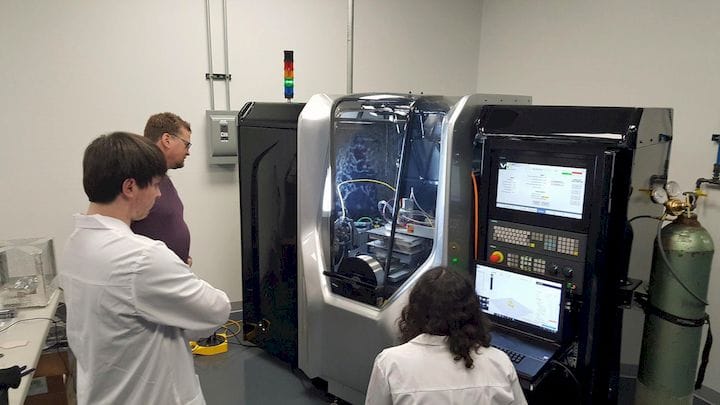![Liquid metal 3D printing at Xerox [Source: Xerox]](https://fabbaloo.com/wp-content/uploads/2020/05/image-asset_img_5eb097ae0b5a2.jpg)
As industrial interest in 3D printing grows exponentially, new players are sure to arrive. One of them is likely to be Xerox.
We’ve known, officially, for a few months, that Xerox intends on entering the 3D print space in a big way. Their CEO released a three-year roadmap for Xerox to participate in the industry, and it covers many aspects.
A curious post on their website reveals a bit more about Xerox’s 3D printing strategy.
It seems they are focusing on developing 3D printing solutions for industry, specifically to utilize materials that are closer to the needs of the application, rather than the needs of the equipment doing the 3D printing. They believe their considerable expertise in developing powders for their other lines of business could be of great assistance in this regard.
Another highly useful technology they already have in-house is multi-nozzle componentry. These would be normally used for dot-printing of high-resolution 2D images, for example. However, this tech could easily be repurposed for 3D printing applications, especially if powder is involved. Sounds like a binder jet system, does it not? [UPDATE: Xerox informs us that the multi-nozzle tech is actually dedicated for material extrusion, and is not an inkjet head for binder jetting.]
![Xerox multi-nozzle technology [Source: Xerox]](https://fabbaloo.com/wp-content/uploads/2020/05/xerox-multi-nozzle-extrusion-technology_img_5eb097ae72352.jpg)
They also talk about “liquid metal 3D printing”, which is the technology they recently landed by their acquisition of metal 3D printer developer Vader Systems. This technology involves heating common welding wire via electricity, and depositing the liquid metal repeatedly to build up a fully complete metal object.
The liquid metal process is quite different from binder jets and requires neither powder nor specialized materials. Thus it seems that Xerox intends on deploying multiple 3D printing processes in their future lines of equipment.
I like to contrast their strategy with that of HP, another large operator that has added 3D printing capabilities to their product line.
HP began by experimenting with 3D printing in and around 2010 by selling re-branded Stratasys FDM equipment. This may seem strange for such a large company to do, as they might be expected to design their own gear. However, I believe it was a very strategic move as it allowed their operatives to infiltrate the 3D printing ecosystem deeply to learn what’s going on with materials, competitors, services and much more. They then discontinued the Stratasys relationship and disappeared for some years.
They suddenly resurfaced with announcements of new equipment using new processes. The process HP developed is quite flexible and can be used in a variety of ways to produce larger quantities of prints in good quality, many materials, unusual properties and even full color. So far it seems they have been very successful. I suspect their initial experiment gave them sufficient information to devise a successful strategy for equipment development and deployment, which we now see.
Xerox seems to be taking a very different approach. They did not partner with anyone initially to learn the space. Instead, they purchased a small startup vendor of metal 3D printing gear. I’m not sure they’re going to gain a fully comprehensive view of the 3D printing universe from just that acquisition, as Vader Systems focuses on metal applications, and Xerox needs data around binder jet solutions.
What does all this suggest? It could be that if Xerox’s strategy is to gain information by acquisition, we could see them acquire a polymer-based 3D printer manufacturer that could fit with their in-house technologies.
It’s not clear which vendor that might be, but there are several possibilities. For the acquired company, this could be very good news as they would likely be asked to continue development, except that they would be strongly funded by Xerox, and be able to leverage Xerox’s legendary sales force network.
We may find out more about their plans next week at the RAPD + TCT event, as Xerox has booked a large exhibition space, equivalent in size to Sintratec, Roboze and 3D Platform, even though their only known 3D printing product at this time is the Vader Systems equipment.











